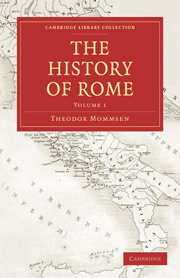Book contents
- Frontmatter
- PREFACE
- PREFATORY NOTE BY THE TRANSLATOR
- EXTRACT FROM DR. MOMMSEN'S PREFACE
- Contents
- BOOK FIRST THE PERIOD ANTERIOR TO THE ABOLITION OF THE MONARCHY
- CHAPTER I INTRODUCTION
- CHAPTER II THE EARLIEST MIGRATIONS INTO ITALY
- CHAPTER III THE SETTLEMENTS OF THE LATINS
- CHAPTER IV THE BEGINNINGS OF ROME
- CHAPTER V THE ORIGINAL CONSTITUTION OF ROME
- CHAPTER VI THE NON-BURGESSES AND THE REFORMED CONSTITUTION
- CHAPTER VII THE HEGEMONY OF ROME IN LATIUM
- CHAPTER VIII THE UMBRO-SABELLIAN STOCK—BEGINNINGS OF THE SAMNITES
- CHAPTER IX THE ETRUSCANS
- CHAPTER X THE HELLENES IN ITALY.—MARITIME SUPREMACY OF THE TUSCANS AND CARTHAGINIANS
- CHAPTER XI LAW AND JUSTICE
- CHAPTER XII RELIGION
- CHAPTER XIII AGRICULTURE, TRADE, AND COMMERCE
- CHAPTER XIV MEASURING AND WRITING
- CHAPTER XV ART
- BOOK SECOND FROM THE ABOLITION OF THE MONARCHY IN ROME TO THE UNION OF ITALY
- APPENDIX: ON THE PATRICIAN CLAUDII
- ADDITIONS AND CORRECTIONS
CHAPTER VII - THE HEGEMONY OF ROME IN LATIUM
Published online by Cambridge University Press: 05 October 2010
- Frontmatter
- PREFACE
- PREFATORY NOTE BY THE TRANSLATOR
- EXTRACT FROM DR. MOMMSEN'S PREFACE
- Contents
- BOOK FIRST THE PERIOD ANTERIOR TO THE ABOLITION OF THE MONARCHY
- CHAPTER I INTRODUCTION
- CHAPTER II THE EARLIEST MIGRATIONS INTO ITALY
- CHAPTER III THE SETTLEMENTS OF THE LATINS
- CHAPTER IV THE BEGINNINGS OF ROME
- CHAPTER V THE ORIGINAL CONSTITUTION OF ROME
- CHAPTER VI THE NON-BURGESSES AND THE REFORMED CONSTITUTION
- CHAPTER VII THE HEGEMONY OF ROME IN LATIUM
- CHAPTER VIII THE UMBRO-SABELLIAN STOCK—BEGINNINGS OF THE SAMNITES
- CHAPTER IX THE ETRUSCANS
- CHAPTER X THE HELLENES IN ITALY.—MARITIME SUPREMACY OF THE TUSCANS AND CARTHAGINIANS
- CHAPTER XI LAW AND JUSTICE
- CHAPTER XII RELIGION
- CHAPTER XIII AGRICULTURE, TRADE, AND COMMERCE
- CHAPTER XIV MEASURING AND WRITING
- CHAPTER XV ART
- BOOK SECOND FROM THE ABOLITION OF THE MONARCHY IN ROME TO THE UNION OF ITALY
- APPENDIX: ON THE PATRICIAN CLAUDII
- ADDITIONS AND CORRECTIONS
Summary
Extension of the Roman territory.
The brave and impassioned Italian race doubtless never lacked occasion for feuds among themselves and with their neighbours: as the country flourished and civilization advanced, feuds must have become gradually changed into wars, and raids for pillage into regular conquests, and political powers must have begun to assume shape. No Italian Homer, however, has preserved for us a picture of these earliest frays and plundering excursions, in which the character of nations is moulded and expressed, like the mind of the man in the sports and enterprises of the boy; nor does historical tradition enable us to form a judgment, with even approximate accuracy, as to the outward development of power and comparative resources in the several cantons of Latium. It is only in the case of Rome, at the utmost, that we can trace in some degree the extension of its power and of its territory. The earliest demonstrable boundaries of the united Roman community have been already stated (P. 48); in the landward direction they were on an average just about five miles distant from the capital of the canton, and it was only toward the coast that they extended as far as the mouth of the Tiber (Ostia), at a distance of somewhat more than fourteen miles from Rome. “Larger and smaller tribes,” says Strabo, in his description of the primitive Rome, “surrounded the new city, some of whom dwelt in independent villages, and were not subordinate to any national union.” It seems to have been at the expense of these neighbours of kindred lineage in the first instance that the earliest extensions of the Roman territory took place.
- Type
- Chapter
- Information
- The History of Rome , pp. 104 - 119Publisher: Cambridge University PressPrint publication year: 2010First published in: 1862

